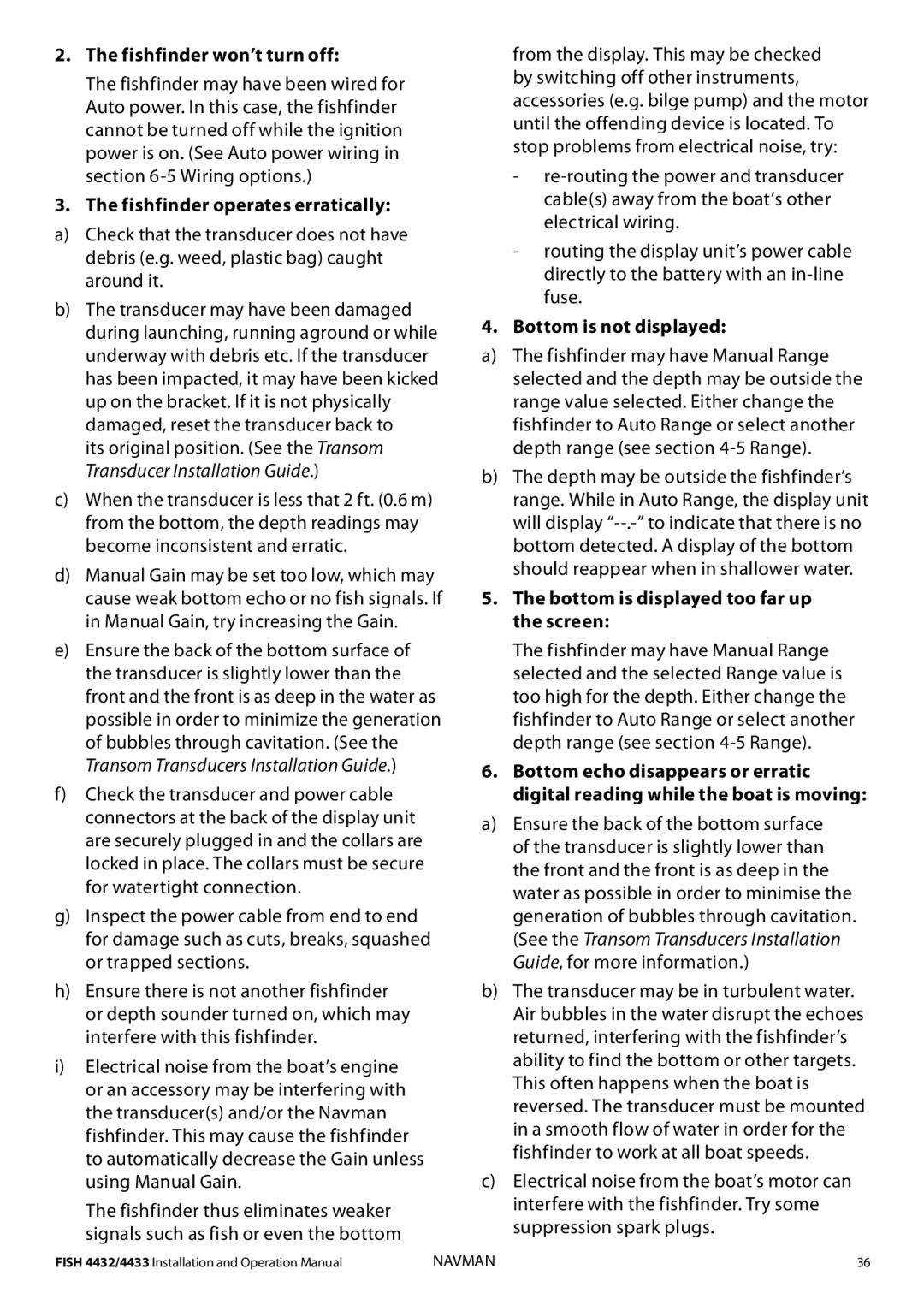2.The fishfinder won’t turn off:
The fishfinder may have been wired for Auto power. In this case, the fishfinder cannot be turned off while the ignition power is on. (See Auto power wiring in section
3.The fishfinder operates erratically:
a)Check that the transducer does not have debris (e.g. weed, plastic bag) caught around it.
b)The transducer may have been damaged during launching, running aground or while underway with debris etc. If the transducer has been impacted, it may have been kicked up on the bracket. If it is not physically damaged, reset the transducer back to
its original position. (See the Transom Transducer Installation Guide.)
c)When the transducer is less that 2 ft. (0.6 m) from the bottom, the depth readings may become inconsistent and erratic.
d)Manual Gain may be set too low, which may cause weak bottom echo or no fish signals. If in Manual Gain, try increasing the Gain.
e)Ensure the back of the bottom surface of the transducer is slightly lower than the front and the front is as deep in the water as possible in order to minimize the generation of bubbles through cavitation. (See the Transom Transducers Installation Guide.)
f)Check the transducer and power cable connectors at the back of the display unit are securely plugged in and the collars are locked in place. The collars must be secure for watertight connection.
g)Inspect the power cable from end to end for damage such as cuts, breaks, squashed or trapped sections.
h)Ensure there is not another fishfinder or depth sounder turned on, which may interfere with this fishfinder.
i)Electrical noise from the boat’s engine or an accessory may be interfering with the transducer(s) and/or the Navman fishfinder. This may cause the fishfinder to automatically decrease the Gain unless using Manual Gain.
The fishfinder thus eliminates weaker signals such as fish or even the bottom
from the display. This may be checked by switching off other instruments, accessories (e.g. bilge pump) and the motor until the offending device is located. To stop problems from electrical noise, try:
-
-routing the display unit’s power cable directly to the battery with an
4.Bottom is not displayed:
a)The fishfinder may have Manual Range selected and the depth may be outside the range value selected. Either change the fishfinder to Auto Range or select another depth range (see section
b)The depth may be outside the fishfinder’s range. While in Auto Range, the display unit will display
5.The bottom is displayed too far up the screen:
The fishfinder may have Manual Range selected and the selected Range value is too high for the depth. Either change the fishfinder to Auto Range or select another depth range (see section
6.Bottom echo disappears or erratic digital reading while the boat is moving:
a)Ensure the back of the bottom surface of the transducer is slightly lower than the front and the front is as deep in the water as possible in order to minimise the generation of bubbles through cavitation. (See the Transom Transducers Installation Guide, for more information.)
b)The transducer may be in turbulent water. Air bubbles in the water disrupt the echoes returned, interfering with the fishfinder’s ability to find the bottom or other targets. This often happens when the boat is reversed. The transducer must be mounted in a smooth flow of water in order for the fishfinder to work at all boat speeds.
c)Electrical noise from the boat’s motor can interfere with the fishfinder. Try some suppression spark plugs.
FISH 4432/4433 Installation and Operation Manual | NAVMAN | 36 |
